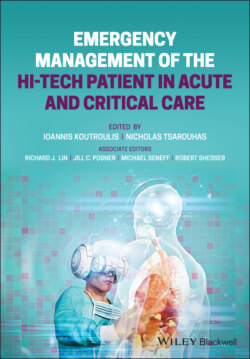Читать книгу Emergency Management of the Hi-Tech Patient in Acute and Critical Care - Группа авторов - Страница 25
Routine Replacement Temporary Tubes
ОглавлениеNG and OG tubes can be placed and replaced by home nursing or properly trained family members (Table 1.3). NG/OG tubes should be replaced approximately every 7–10 days. Properly sizing the tubing is necessary prior to placement. When choosing a tube size, most feedings can be given with a 6 or 8 Fr tube in pediatric patients and a 12–14 Fr tube in adult patients. Appropriate tube insertion depth is classically measured by taking the feeding tube and measuring from the tip of the nose to the ear lobe and finally to the xyphoid. Several pediatric studies have found that this measurement may underestimate tube depth and result in tubes that terminate in the distal esophagus and pose an aspiration risk. Therefore, in pediatric patients, a better measurement is either using published age‐related height‐based measurements or by measuring from the tip of the nose to the ear lobe and then to the midpoint between the xyphoid and umbilicus. For OG tubes, the measurement should start at the mouth. Once the appropriate tube size and depth of insertion are determined, the same steps may be followed for either NG or OG tube placement, substituting the nasal passages for the oropharynx in the place of OG placement (Table 1.3). Finally, NG/OG tube placement is an uncomfortable procedure, and patients should be treated with topical lidocaine either as 4% lidocaine spray, 2% lidocaine jelly, or nebulized 4% lidocaine prior to the procedure.
Table 1.2 Enteric feeding device contraindications.
| NG/OG feeding tubes | G‐tubes | J‐tubes |
| Maxillofacial disordersEsophageal or oropharyngeal tumors or traumaLaryngectomyConfirmed skull or cervical spine injury above C4Clotting dysfunctionIngestion of corrosive substance | Severe gastroesophageal refluxGastric dysmotilityGastric outlet obstruction | AscitesCrohn’s diseaseImmunosuppression |
Discuss with appropriate consulting service prior to NG/OG placement
Table 1.3 NG tube insertion.
| Supplies |
| Nasogastric tubeSterile water50 mL catheter tip syringeTape to secure tubing |
| Stepwise procedure |
| Position patient sitting upright with neck midline; avoid hyperextension.Lubricate the NG tip with sterile water. Avoid jelly as it will affect the pH.Direct the tube into one of the nostrils and, keeping the tube horizontal, aim the tube directly posterior. Ask the patient to swallow, as this will help guide the tube into the esophagus by closing the epiglottis.Once the tube passes through the nasopharynx, have the patient lean forward and bend his/her chin while continuing to swallow which will further push the tube down the esophagus.Continue to pass the tube until you reach the predetermined tube depth.Stop and remove the tube if the patient has any signs of respiratory distress.Attach a 50 ml syringe and aspirate contents to the tube.Test aspirate on pH paper, any value below 4.0 is considered gastric contents.Secure the tube by taping to the nose and face. |
NG/OG tube placement can be verified by the aspiration of gastric contents with a pH < 4.0. However, be aware that medications can change the gastric pH, and in a patient with reflux, an esophageal aspirate may have the same pH as a gastric aspirate. Likewise, the aspiration of “gastric fluid” does not confirm gastric placement alone because there is fluid within the bronchial tree and distal esophagus that resembles gastric fluid. In addition, lack of fluid aspirate can lead to falsely believing the tube is not in the stomach when the tube collapses or is above the fluid level. Finally, auscultation is an unreliable method of determining NG/OG tube placement because the sound of an NG tube in the thorax may transmit to the upper abdomen. X‐ray confirmation remains the gold standard for NG/OG tube placement in both adult and pediatric patients.
Bedside placement of ND and NJ feeding tubes is still controversial; however, there are increasingly more studies supporting this practice. Most research has focused on the placement of ND tubes. ND tube placement is similar to NG tube placement; however, the patient is kept in the right‐lateral decubitus position. Several adjunctive measures have been described including the use of promotility agents and gas insufflation to promote tube position past the pylorus. Of note, these techniques are better described in the adult patients and less so in pediatric patients. All post‐pyloric feeding tubes should be confirmed with an X‐ray prior to use.
